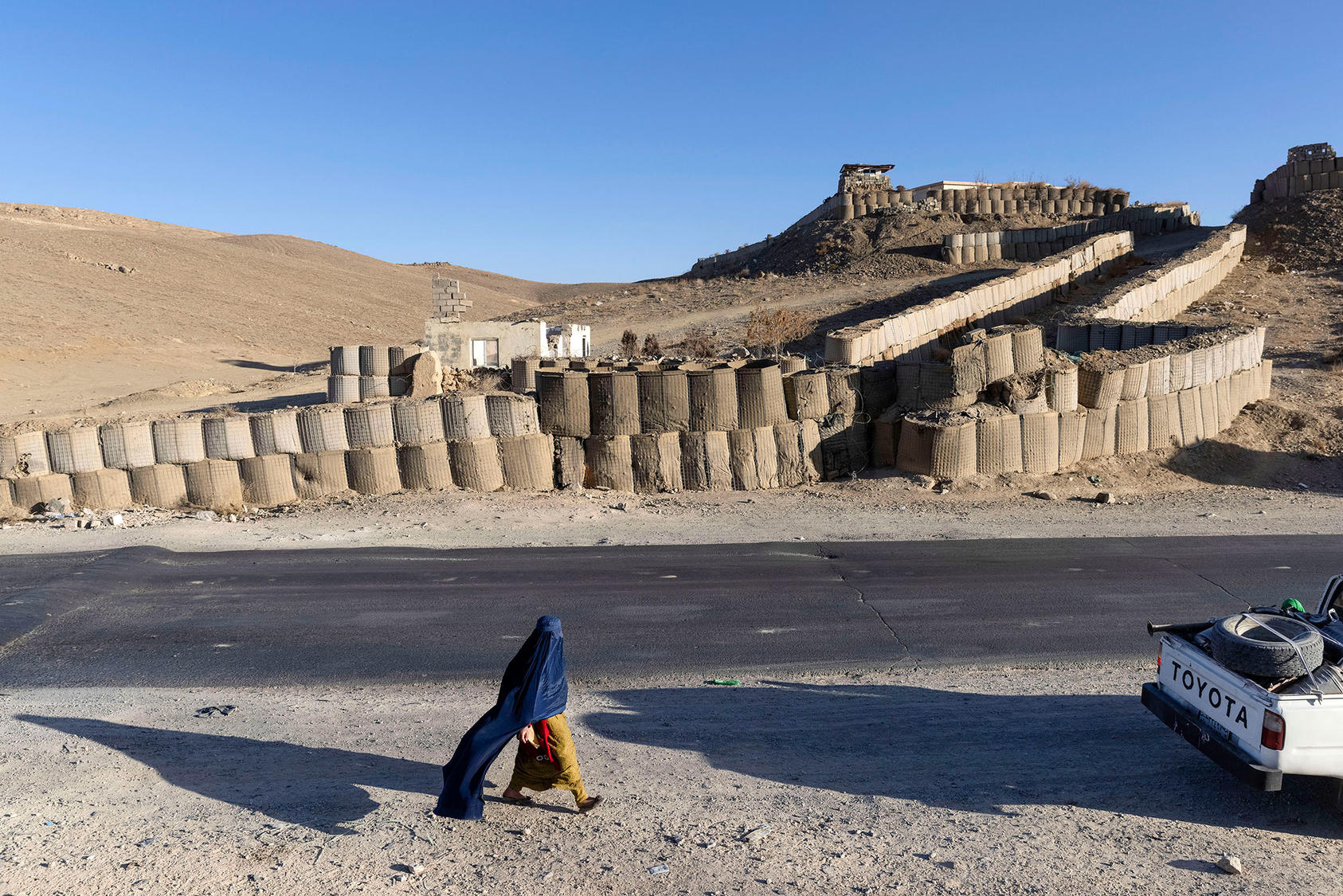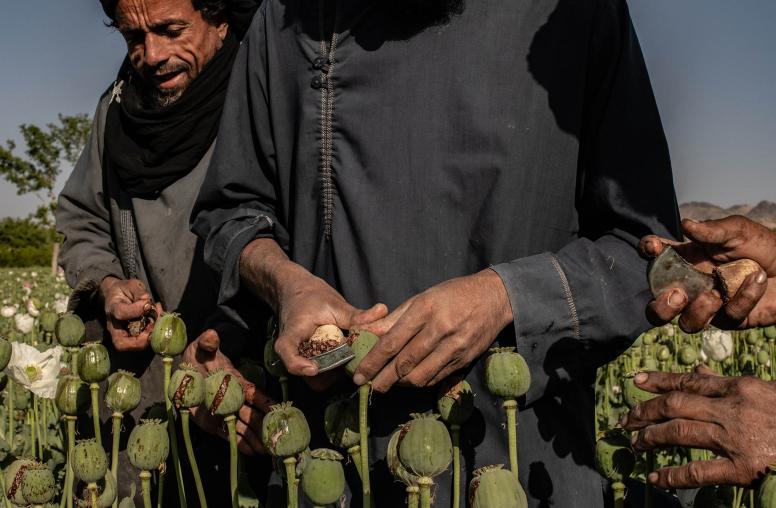How the Taliban’s Hijab Decree Defies Islam
The worst-case scenario for Afghan women is playing out before our eyes. The international community cannot sit by idly.
The Taliban continued this week to roll back Afghan women’s rights by decreeing women must be fully covered from head to toe — including their faces — to appear in public. This follows decrees limiting women’s ability to work, women’s and girls’ access to education and even limiting their freedom of movement. Afghan women are rapidly facing the worst-case scenario many feared when the Taliban took over last summer. While the Taliban justify these moves as in accordance with Islam, they are, in fact, contradicting Islamic tradition and Afghan culture as the group looks to resurrect the full control they had over women and girls when they ruled in the 1990s.

The two-page order says that because “99 percent of Afghan women are already observing Islamic hijab there is no reason for the remaining one percent not to follow the Shariah-prescribed hijab.” The order further states that black clothes and scarves that are not tight-fitting are an acceptable type of hijab along with the preferred burqa. But the first and best form of “obeying hijab” for women — meaning covering their faces — is to “not leave home without necessity.”
Domestic violence in Afghanistan is already high: A 2021 poll of over 200 women’s rights experts ranked Afghanistan as the worst place in the world to be a woman. Before the Taliban’s takeover, there were laws and policies, and governmental and non-governmental institutions mandated to protect women’s rights. Since their takeover in August, the Taliban have suspended Afghanistan’s constitution and other laws protecting women’s rights. Additionally, the Ministry of Women’s Affairs, independent commissions such as the Afghan Independent Human Rights Commission and the Commission to Eliminate Violence Against Women, and women’s rights organizations have all been suspended.
In the absence of protection mechanisms for women, violence against women at home and other forms of abuse perpetrated against Afghan women and girls are on the rise and can be expected to increase more due to this decree.
The Taliban Prove They Haven’t Changed
Rather than changing their reviled policies from the 1990s, the Taliban are reverting to form as they seek to demonstrate their hardline credentials over groups like Islamic State-Khorasan Province and Hizb-ut-Tahrir. The Taliban have even called on Afghan media to explain the importance of the hijab for women.
The second part of the Taliban’s order lists punishments for violators: First a warning to the (male) head of the household, then a summons to a government office, followed by three days in jail for the male guardian and ultimately a court case with even harsher punishments to follow. The order is silent on whether women who do not cover properly will be beaten as they were in the 1990s, but it does specify that “women who conduct activities within organs related to the Emirate and do not observe hijab are to be dismissed from their positions.”
The Taliban say the decrees is based on Islam although the vast majority of Muslims — outside Iran and Saudi Arabia — do not follow the type of dress code the Taliban are prescribing for Afghan women. Given that Afghanistan is an overwhelmingly Muslim, traditional and patriarchal society, a significant number of conservative Afghan men will not object to the Taliban’s decision.
The Taliban are reinforcing Afghanistan’s patriarchal system, where men decide for and on behalf of women. The order legitimizes men’s control over women and the humiliation of women in public, paving the way for increased domestic violence, harassment and oppression of Afghan women and girls. Further, the decree gives ammunition to conservative Afghan men who aim to prevent women from exercising their right to participate in public life. It essentially encourages harassment and oppression of women and girls. Fundamentally, it shows that the Taliban’s policies concerning women have not changed.
The Taliban’s hijab decree not only runs counter to Afghanistan’s history and culture, but it also demonstrates their narrow understanding of Islam.
An Affront to Afghan history
While the exact time when the burqa was introduced as a cover for women in Afghanistan is unknown, Afghans believe that the burqa — or chadari as Afghans refer to it — was imported from Persia and later in the 20th century from India. It is therefore a relatively modern and foreign phenomenon. Over the past several decades Afghan women have categorically rejected the narrative that the burqa is a part of an Afghan traditional dress code for women.
Afghanistan is an agriculture-centered country, where women have been active in farming. Loose clothing and head scarves have been and continue to be worn by women throughout the country to allow them to work on farms, forests and livestock.
The Taliban are undermining Afghan culture and imposing a type of hijab that was foreign to a majority of Afghan women before the 1990s. Some Afghan women have made the personal choice to wear a burqa in a public setting. But it wasn’t until fundamentalist mujahedeen groups took control of the country in 1992 that many women were forced to wear a burqa to disguise their identity and avoid being harassed by mujahedeen fighters and criminals. Despite the mujahedeen’s decision that women must be fully covered while in public, the vast majority did not submit to this requirement.
In 1996, when the Taliban took control of the country they enforced the state-imposed burqa on women. It wasn’t only the type of cover they imposed on women, but the color of the burqa itself and the clothing underneath was also prescribed. Women found to wear stylish and bright-colored clothes under the burqa were publicly beaten, whipped and humiliated. There was no way around it.
A Narrow Understanding of Islam
The Taliban’s justification for imposing the hijab in the name of Islam and Shariah is contradictory to the spirit of Islam. The Taliban use “hijab” as a synonym for women’s clothing and cover. However, Quranic references to the hijab are not necessarily about women’s clothes. Islam ordained a perdah, or “curtain,” for the wives of the Prophet, not for all Muslim women. A majority of Islamic scholars agree that hijab refers to the curtain in the front door of a home that women in the Prophet Muhammad’s household were obliged to use. According to the Quran and other important Islamic texts and traditions, the face, hands and the feet are not included as part of required forms of Islamic dress.
The Taliban’s proposed penalties for violating their dress code are another point of dubious Islamic legality, stating that the male guardian of any woman who does not follow the obligations in this order will be punished. Yet according to basic legal principles and Shariah norms one cannot be arrested or punished for the action of others — not to mention the implication that women are under the control of the men who would be punished for their alleged transgressions.
Perhaps the most troubling point about the Taliban’s order, however, is that essentially calls on woman to avoid public life: “The best way to obey the hijab for women is to not go out of the home.” Again, to stay at home was an option for women in the Prophet’s household not for all Muslim women, as the Quran clearly states in Chapter 33:33.
By ordering women to stay at home, the Taliban are throwing more obstacles in front of women to prevent them from taking part in public life. This seemingly ignores the vital role Muslim women have played in social, political, economic and cultural life throughout the history of Islam. For example, one of the Prophet’s wives, Khadija, was a successful businesswoman who managed and employed men as her subordinates and partners, including the Prophet. Women have held positions as mayors, judges, military commanders, teachers, architects and so on throughout the Muslim world. Justifying restrictions on women’s mobility and access to rights has nothing to do with Islam. If anything, it proves the Taliban’s ignorance of Islam — and the ignorance of others who have employed Islam to suppress women.
Now What?
In response to the hijab decree, U.S. State Department Spokesperson Ned Price said Monday, "We've addressed it directly with the Taliban … There are steps that we will continue to take to increase pressure on the Taliban to reverse some of these decisions, to make good on the promises that they have made."
Since taking power, the Taliban have shown that they are largely immune to pressure. Despite harsh sanctions and the withholding of diplomatic recognition, they have remained unbowed and unwilling to concede. While the international community has predicated diplomatic recognition on maintaining Afghan girls’ access to education, the Taliban have made moves to limit such access. After 20 years of hard-won gains, Afghan women and girls are watching their rights evaporate before their eyes.
“What is happening right now in Afghanistan is the most serious women’s rights crisis in the world today,” Heather Barr, the associate women’s rights director at Human Rights Watch, recently wrote. The international community cannot sit by idly. The U.N. Security Council is meeting today to discuss the Taliban’s decree. Closed door conversations and statements of condemnation are not enough — urgent action is needed now.
Afghanistan is also in the midst of a massive humanitarian and hunger crisis. The Taliban need financial assistance and sanctions relief to address these humanitarian challenges. They also want formal diplomatic recognition. The United States and concerned partners should leverage financial assistance and sanctions relief to incentivize the Taliban to respect women’s rights. It is the least that can be done for the brave Afghan women who have and continue to stand up against the Taliban and their repression.
Mohammad Osman Tariq is a senior advisor for the Religion and Inclusive Societies program at USIP.



